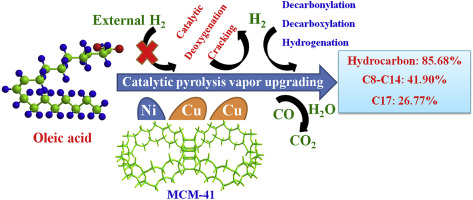当前位置:
X-MOL 学术
›
Renew. Energy
›
论文详情
Our official English website, www.x-mol.net, welcomes your
feedback! (Note: you will need to create a separate account there.)
Efficient and stable Ni-Cu catalysts for ex situ catalytic pyrolysis vapor upgrading of oleic acid into hydrocarbon: Effect of catalyst support, process parameters and Ni-to-Cu mixed ratio
Renewable Energy ( IF 9.0 ) Pub Date : 2020-07-01 , DOI: 10.1016/j.renene.2020.03.058 Yunwu Zheng , Jida Wang , Can Liu , Yi Lu , Xu Lin , Wenbin Li , Zhifeng Zheng
Renewable Energy ( IF 9.0 ) Pub Date : 2020-07-01 , DOI: 10.1016/j.renene.2020.03.058 Yunwu Zheng , Jida Wang , Can Liu , Yi Lu , Xu Lin , Wenbin Li , Zhifeng Zheng

|
Abstract To eliminate the problematic need for liquid phase, high temperature, and high pressure, as well as the excessive consumption of hydrogen and production of aromatic hydrocarbons, associated with traditional aviation oil preparation processes, Ni–Cu bimetallic catalysts were synthesized and evaluated for ex situ catalytic pyrolysis vapor upgrading of oleic acid under a N2 atmosphere. The effects of catalyst support (AC, Al2O3, ZrO2, HZSM-5, HUSY, Hβ and MCM-41), pyrolysis process parameters (pyrolysis temperature, catalytic temperature and amount of oleic acid injected), and the mixing ratio of modified metals (Ni:Cu = 0:1,2,1:1,1:2,1:0) on the catalytic conversion of oleic acid to high-quality chemicals were studied. The catalysts were characterized by XRD, BET and NH3-TPD. Modified bimetallic catalysts show great potential for green diesel production without the use of H2 feed. The abundance of Bronsted acid sites favors HDO routes (such as HZSM-5, HUSY, Hβ and MCM-41), while Lewis acid sites (such as ZrO2 and Al2O3) favor hydrogenation and decarbonylation reactions. The addition of Cu enhances the reducibility of Ni and inhibits the cracking reaction and deactivation caused by coke. The addition of Ni effectively promotes the conversion of oleic acid, accelerates the fracture of C–C and effectively improves the production of hydrocarbons. The highest conversion was 100% with 85.68% selectivity towards hydrocarbons under pyrolysis at 450 °C, a catalytic temperature of 500 °C, and a feed quantity of oleic acid of 0.25 ml/min using Ni–2Cu/MCM-41 catalysts, and the oxygen removal efficiency and selectivity of C17 hydrocarbon were the highest (85.68% and 26.77%, respectively). The main products were olefins. In addition, the regenerated catalyst had good stability and could be used for at least 3 reaction cycles without observation of significant deactivation.
中文翻译:

高效稳定的 Ni-Cu 催化剂用于油酸异位催化热解蒸汽升级为烃:催化剂载体、工艺参数和 Ni-Cu 混合比的影响
摘要 为解决传统航油制备工艺对液相、高温、高压的需求,以及氢气消耗和芳烃生成过多等问题,合成并评价了Ni-Cu双金属催化剂的性能。 N2 气氛下油酸的原位催化热解蒸汽升级。催化剂载体(AC、Al2O3、ZrO2、HZSM-5、HUSY、Hβ和MCM-41)、热解工艺参数(热解温度、催化温度和油酸注入量)、改性金属混合比的影响( Ni:Cu=0:1,2,1:1,1:2,1:0)对油酸催化转化为优质化学品的研究。通过XRD、BET和NH3-TPD对催化剂进行表征。改性双金属催化剂在不使用 H2 原料的情况下显示出巨大的绿色柴油生产潜力。大量的布朗斯台德酸位有利于 HDO 路线(如 HZSM-5、HUSY、Hβ 和 MCM-41),而路易斯酸位(如 ZrO2 和 Al2O3)有利于氢化和脱羰反应。Cu的加入提高了Ni的还原性,抑制了焦炭引起的裂化反应和失活。Ni的加入有效地促进了油酸的转化,加速了C-C的断裂,有效提高了烃类的产量。在 450 °C、500 °C 的催化温度和 0.25 ml/min 的油酸进料量下,使用 Ni-2Cu/MCM-41 催化剂,最高转化率为 100%,对烃的选择性为 85.68%,C17烃的脱氧效率和选择性最高(分别为85.68%和26.77%)。主要产品为烯烃。此外,再生催化剂具有良好的稳定性,可以使用至少 3 个反应循环,而没有观察到明显的失活。
更新日期:2020-07-01
中文翻译:

高效稳定的 Ni-Cu 催化剂用于油酸异位催化热解蒸汽升级为烃:催化剂载体、工艺参数和 Ni-Cu 混合比的影响
摘要 为解决传统航油制备工艺对液相、高温、高压的需求,以及氢气消耗和芳烃生成过多等问题,合成并评价了Ni-Cu双金属催化剂的性能。 N2 气氛下油酸的原位催化热解蒸汽升级。催化剂载体(AC、Al2O3、ZrO2、HZSM-5、HUSY、Hβ和MCM-41)、热解工艺参数(热解温度、催化温度和油酸注入量)、改性金属混合比的影响( Ni:Cu=0:1,2,1:1,1:2,1:0)对油酸催化转化为优质化学品的研究。通过XRD、BET和NH3-TPD对催化剂进行表征。改性双金属催化剂在不使用 H2 原料的情况下显示出巨大的绿色柴油生产潜力。大量的布朗斯台德酸位有利于 HDO 路线(如 HZSM-5、HUSY、Hβ 和 MCM-41),而路易斯酸位(如 ZrO2 和 Al2O3)有利于氢化和脱羰反应。Cu的加入提高了Ni的还原性,抑制了焦炭引起的裂化反应和失活。Ni的加入有效地促进了油酸的转化,加速了C-C的断裂,有效提高了烃类的产量。在 450 °C、500 °C 的催化温度和 0.25 ml/min 的油酸进料量下,使用 Ni-2Cu/MCM-41 催化剂,最高转化率为 100%,对烃的选择性为 85.68%,C17烃的脱氧效率和选择性最高(分别为85.68%和26.77%)。主要产品为烯烃。此外,再生催化剂具有良好的稳定性,可以使用至少 3 个反应循环,而没有观察到明显的失活。











































 京公网安备 11010802027423号
京公网安备 11010802027423号